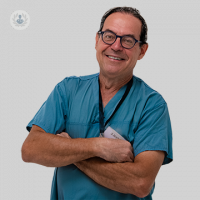Tummy tucks: who needs an abdominoplasty and what does it involve?
Written by:While losing weight is almost always a good thing for your general wellbeing, losing too much too fast can leave you with loose skin around your tummy. Loose skin can look unsightly and can have severe effects on a person’s self-esteem. This is one reason why many people are opting for abdominoplasty or “tummy tucks”. Renowned plastic surgeon Mr Giovanni Ferrando explains this procedure:

What is an abdominoplasty?
Abdominoplasty, also known as a “tummy tuck” is an operation that aims to tighten the skin of the abdomen to give the appearance of a flatter stomach. The procedure involves removing excess skin and fat and surgically repairing any separation of the abdominal muscles or hernias that are found to be contributing to the loose appearance of the area.
The most modern techniques usually include liposuction in the areas which is treated.
Why get a tummy tuck?
Abdominoplasty is done in patients who, for various reasons, have excess skin on the abdomen.
The reasons for this excess skin can include:
- After pregnancies
- After losing a lot of weight, especially if this weight is lost very quickly
- Loss of elasticity of the skin
What are the steps of the abdominoplasty procedure?
- Consultations
Before having a tummy tuck, it is essential to have at least two or three consultations in which the surgeon, in addition to evaluating the tone of the skin, also checks the state of the muscles of the abdominal wall.
In these consultations, your surgeon will explains the abdominoplasty procedure to you and discuss your options. It is important to be clear about your aesthetic goals and manage expectations, with good communication between patient and surgeon.
Preoperative and ECG examinations are also indispensable.
- The incision
The procedure is performed with a horizontal incision. A mini-tummy tuck may only require a six-inch incision, while most run from hip to hip, following the bikini line so it is easily hidden by clothing.
- Removing excess skin
The surgeon separates the navel from the surrounding skin. Excess skin and fat is removed. If the muscle are weak or divided, the surgeon can fix the problem in the same operation. Small hernias can be fixed as well. Finally, the belly button is repositioned.
- Closing
The incision is closed, using sutures, clips, or special tape, after which the abdomen is dressed with bandages. A thin draining tube is usually inserted beneath the incision to drain any excess fluid that accumulates immediately after the operation. A compression garment may also be applied to provide support to the area during the healing process.
What complications can occur with abdominoplasty?
All operations carry certain risks of complications. Tummy tucks are no different, and the risks vary according to the patient’s age, lifestyle, and body shape. Your surgeon will fully discuss all risks with you before the surgery.
How long does recovery take after abdominoplasty?
Recovery time is usually about 15 days.
The drainage tube(s) is usually removed before leaving the clinic, but the dressing and compression garment may need to stay on for a few weeks after.
During the first ten days the patient will have to take care when moving in order not to pull the scar which is over the pubis. After a month you can usually restart physical activity.


